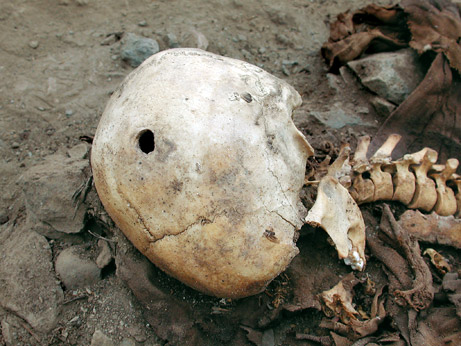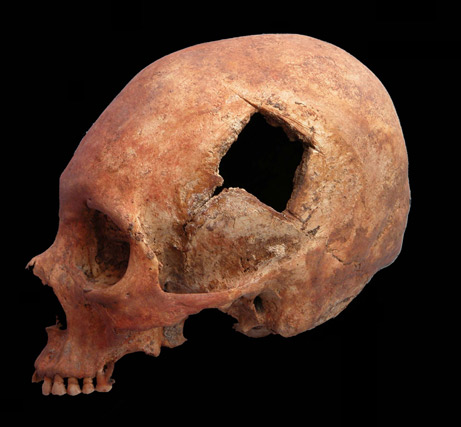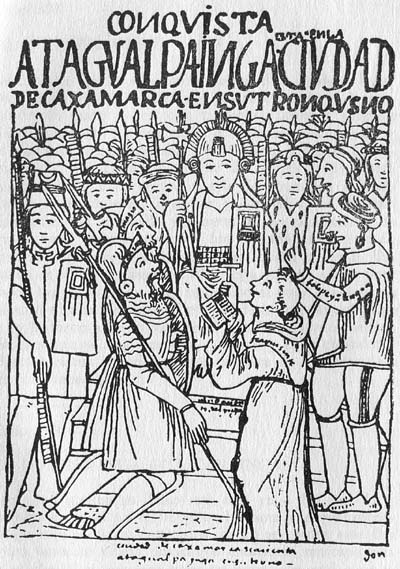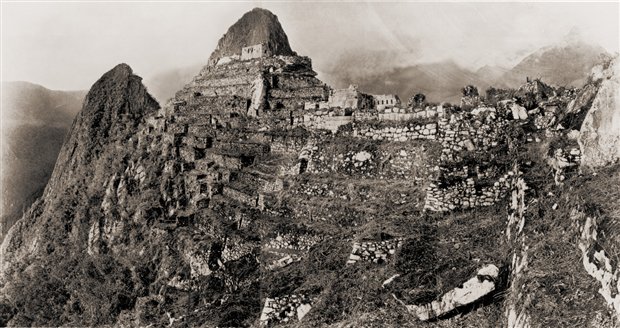Inca Skull With 16th Century Conquistador Bullet Hole Discovered in Peru

First Known Gunshot Victim in Americas Discovered
National Geographic News
June 19, 2007
The first known gunshot victim in the Americas was an Inca Indian killed by a musket-wielding Spaniard nearly 500 years ago in Peru, scientists announced today.
The casualty’s skeleton was discovered in 2004 while excavating an Inca cemetery in the Lima suburb of Puruchuco—less than a mile from thousands of Inca mummy bundles discovered by Peruvian archaeologist Guillermo Cock.
The individual may have been killed during an Inca uprising against Spanish conquistadors in 1536, according to Cock, who also led the new excavations.
(more…)
Skull Surgery Among the Incas

Incan Skull Surgery
Science News
April 25th, 2008
When Incan healers scraped or cut a hunk of bone out of a person’s head, they meant business. Practitioners of this technique, known as trepanation, demonstrated great skill more than 500 years ago in treating warriors’ head wounds and possibly other medical problems, rarely causing infections or killing their patients, two anthropologists find.
Trepanation emerged as a promising but dangerous medical procedure by about 1,000 years ago in small communities near the eventual Inca heartland in Peru’s Andes mountains, say Valerie Andrushko of Southern Connecticut State University in New Haven and John Verano of Tulane University in New Orleans. Incan healers later mastered certain trepanation methods, performing them safely and frequently.
“Far from the idea of ‘savages’ drilling crude holes in skulls to release evil spirits, these ancient people were highly skilled as surgeons,” Andrushko says…
(more…)
Saving the Incas’ Mother Tongue, Quechua

June 7, 2008
Armed With a Pen, and Ready to Save the Incas’ Mother Tongue
NYT
CALLAO, Peru
“Somewhere in La Mancha, in a place whose name I do not care to remember, a gentleman lived not long ago.”
Simple enough, right? But not for Demetrio Túpac Yupanqui.
Instead, he regales visitors to his home here in this gritty port city on Lima’s edge with his Quechua version of the opening words of “Don Quixote”:
“Huh k’iti, la Mancha llahta suyupin, mana yuyarina markapin, yaqa kay watakuna kama, huh axllasqa wiraqucha.”
(Above: A 16th century drawing of Francisco Pizarro meeting the Inca emperor Atahualpa, in Cajamarca, Peru in 1532)
Mr. Túpac Yupanqui, theologian, professor, adviser to presidents and, now, at the sunset of his long life, a groundbreaking translator of Cervantes, greets the perplexed reactions to these words with a wide smile.
“When people communicate in Quechua, they glow,” said Mr. Túpac Yupanqui, who at 85 still appears before his pupils each day in a tailored dark suit. “It is a language that persists five centuries after the conquistadors arrived. We cannot let it die…”
(more…)
German May Have Looted Machu Picchu Long Before Hiram Bingham Arrived

Machu Picchu
German may have found, looted Inca city
June 5, 2008
Newscientist.com
LIMA, Peru — The jungle-shrouded Inca citadel of Machu Picchu may have been rediscovered – and looted – decades before the Yale scholar credited with the find first got there, a researcher said Thursday.
Most academics say Yale University’s Hiram Bingham III rediscovered the site in Peru’s verdant southeastern Andes during a 1911 expedition.
But Paolo Greer, a retired Alaska oil pipeline foreman, says otherwise. Thirty years of digging through files in the United States and Peru led him to maps and documents showing that a German businessman named Augusto R. Berns got there first…
(more…)




